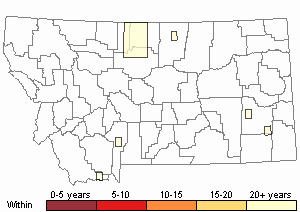View in other NatureServe Network Field Guides
NatureServe
Montana
Utah
Wyoming
Idaho
Wisconsin
British Columbia
South Carolina
Yukon
California
New York
Thomas' Slender Grasshopper - Trimerotropis gracilis
General Description
The following is taken from Brooks (1958), Helfer (1971), Otte (1984), Richman et al. (1993), Vickery and Kevan (1985), and Scott (2010). This is a pale brown or gray grasshopper without forewing bands and heavily streaked and spotted over most of its body. Sometimes it has small areas of orangish spotting. The median carina (ridge) of the pronotum (thorax) is strongly bilobed, cut by two sulci (grooves) anteriorly and distinct posteriorly. The hindwing disk is pale yellow but can vary to a faint greenish or be nearly clear. The dark crossband can be absent, faint or broken with a spur reaching the wing base. The apex is clear or with some smokey cells. The outer face of the hind femur is brown or gray with heavy spotting, and sometimes with an orangish spot at its base. The inner face is mostly bluish black with two pale markings dorsally and a pale ring before the knee. The hind tibia is yellowish or brownish with dark mottling.
Communicative behavior/Crepitation*
Crepitation flights by males are frequent, and a low “snapping or clacking” sound is produced on every third or fourth wing beat, making the crepitation rate slow; the flights are swift, erratic and they drop to the bare ground and run about between crepitations. Both males and females crepitate when disturbed. Femur-tipping and shaking are used in male-to-male aggression encounters (Otte 1970, 1984, and Vickery and Kevan 1985).
*Crepitation is the sound produced by grasshoppers making a clicking or snapping noise with their wings when in flight, during courtship, territorial encounters or being disturbed.
Phenology
Overwinters in the egg stage in bare soil. Hatching and nymph occurrence is unknown. Adults occur from late June to the end of September (Otte 1984, Vickery and Kevan 1985, and Scott 2010).
Diagnostic Characteristics
The following comes from Brooks (1958), Vickery and Kevan (1985), Richman et al. (1993), and Scott (2010). The body length to tip of forewings is 26-36 mm for both males and females.
The Thomas’ Slender Grasshopper can be easily confused with
Great Basin Grasshopper (
T. sparsa). Refer to that species in the Field Guide for comparison (Otte 1984).
Species Range
Montana Range
Range Descriptions

 Native
Native
Range Comments
This species occurs from British Columbia to Saskatchewan, and southward to Arizona and New Mexico. From the west in Oregon and northeastern California, to Montana, Wyoming, Colorado, and New Mexico. In Montana, it has been reported for 11 counties (Otte 1984, Vickery and Kevan 1985, and Scott 2010).
Observations in Montana Natural Heritage Program Database
Number of Observations: 6
(Click on the following maps and charts to see full sized version)
Map Help and Descriptions
Relative Density

Recency


 (Observations spanning multiple months or years are excluded from time charts)
(Observations spanning multiple months or years are excluded from time charts)
Habitat
The Thomas’ Slender Grasshopper inhabits mostly bare ground in sagebrush communities and roadsides (Otte 1984, and Vickery and Kevan 1985).
Food Habits
This species is classed as a mixed feeder of grasses and forbs. Favored and specific species and other food sources have not been reported in the literature (Vickery and Kevan 1985).
Reproductive Characteristics
Courtship takes place on the ground. A male walks toward a female producing single pulses of stridulation* and femur-tipping signals, the number of stridulations increasing as he approaches closer to the female. A receptive female spreads her femora away from her body, the male mounts and copulates. No other details or observations regarding this species’ life cycle are currently known (Otte 1970).
*Stridulation is rubbing one body part against another, usually the hind femur against the forewing in the case of the Band-winged Grasshoppers. This is often used for attracting a female during courtship (Otte 1970).
Stewardship Responsibility
References
- Literature Cited AboveLegend:
 View Online Publication
View Online Publication Brooks, A.R. 1958. Acridoidea of Southern Alberta, Saskatchewan, and Manitoba (Orthoptera). The Canadian Entomologist (Supplement 9) 90:5-92.
Brooks, A.R. 1958. Acridoidea of Southern Alberta, Saskatchewan, and Manitoba (Orthoptera). The Canadian Entomologist (Supplement 9) 90:5-92. Helfer, J.R. 1971. How to Know the Grasshoppers, Crickets, Cockroaches, and Their Allies. Revised edition (out of print), Mineola, NY: Dover Publications.
Helfer, J.R. 1971. How to Know the Grasshoppers, Crickets, Cockroaches, and Their Allies. Revised edition (out of print), Mineola, NY: Dover Publications. Otte, Daniel. 1970. A comparative study of communicative behavior in grasshoppers. Miscellaneous Publications, Museum of Zoology, No. 141. Ann Arbor, MI: University of Michigan.
Otte, Daniel. 1970. A comparative study of communicative behavior in grasshoppers. Miscellaneous Publications, Museum of Zoology, No. 141. Ann Arbor, MI: University of Michigan. Otte, Daniel. 1984. The North American Grasshoppers Volume II. Acrididae (Oedipodinae). Harvard University Press. 366 pp.
Otte, Daniel. 1984. The North American Grasshoppers Volume II. Acrididae (Oedipodinae). Harvard University Press. 366 pp. Richman, D.B., D.C. Lightfoot, C.A. Sutherland, and D.J. Ferguson. 1993. A manual of the grasshoppers of New Mexico. Las Cruces, NM: Cooperative Extension Service, Handbook No. 7.
Richman, D.B., D.C. Lightfoot, C.A. Sutherland, and D.J. Ferguson. 1993. A manual of the grasshoppers of New Mexico. Las Cruces, NM: Cooperative Extension Service, Handbook No. 7. Scott, R.D. 2010. Montana Grasshoppers, Katydids, and Crickets A Pictorial Field Guide to the Orthoptera. MagpieMTGraphics, Billings, MT.
Scott, R.D. 2010. Montana Grasshoppers, Katydids, and Crickets A Pictorial Field Guide to the Orthoptera. MagpieMTGraphics, Billings, MT. Vickery, V. R. and D. K. M. Kevan. 1985. The grasshopper, crickets, and related insects of Canada and adjacent regions. Biosystematics Research Institute, Ottawa, Ontario. Publication Number 1777. 918 pp.
Vickery, V. R. and D. K. M. Kevan. 1985. The grasshopper, crickets, and related insects of Canada and adjacent regions. Biosystematics Research Institute, Ottawa, Ontario. Publication Number 1777. 918 pp.
- Additional ReferencesLegend:
 View Online Publication
View Online Publication
Do you know of a citation we're missing? Capinera, J.L., R.D. Scott, and T.J. Walker. 2004. Field Guide to Grasshoppers, Katydids, and Crickets of the United States. Ithaca, NY. Cornell University Press.
Capinera, J.L., R.D. Scott, and T.J. Walker. 2004. Field Guide to Grasshoppers, Katydids, and Crickets of the United States. Ithaca, NY. Cornell University Press. Hebard, M. 1928. The Orthoptera of Montana. Proceedings of the Academy of Natural Sciences of Philadelphia, Vol. 80:211-306.
Hebard, M. 1928. The Orthoptera of Montana. Proceedings of the Academy of Natural Sciences of Philadelphia, Vol. 80:211-306. Hebard, M. 1932. Notes on Montana Orthoptera. Proceedings of the Academy of Natural Sciences of Philadelphia. V. 84. pp 251-257.
Hebard, M. 1932. Notes on Montana Orthoptera. Proceedings of the Academy of Natural Sciences of Philadelphia. V. 84. pp 251-257. Henry, J.E. 1969. Protozoan and viral pathogens of grasshoppers. Ph.D. Dissertation. Bozeman, MT: Montana State University. 153 p.
Henry, J.E. 1969. Protozoan and viral pathogens of grasshoppers. Ph.D. Dissertation. Bozeman, MT: Montana State University. 153 p. Skinner, K.F. 1995. Plant and grasshopper community composition: indicators & interactions across three spatial scales. M.Sc. Thesis. Bozeman, MT: Montana State University. 144 p.
Skinner, K.F. 1995. Plant and grasshopper community composition: indicators & interactions across three spatial scales. M.Sc. Thesis. Bozeman, MT: Montana State University. 144 p.
- Web Search Engines for Articles on "Thomas' Slender Grasshopper"
- Additional Sources of Information Related to "Insects"





